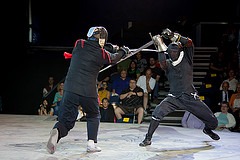After their first night at sparring, a new student of mine engaged me in a conversation. He had enjoyed himself, but felt like he was flailing and a bit out of control. He thought perhaps he should return to simply doing drills for a while.
Sparring is one of the primary ends of our art. It should not be omitted. It’s fun, and it is the best environment to test technique. Now that does not mean that it is all there is, or that it is where you should spend all of your time.
Here’s what I told him:
- Spar, but don’t try to “practice” mechanics in sparring. Learn to be observant. Use it as a tool to understand what you need to work on in other forms of training. There is far too much going on in a fencing match to attempt to make any kind of mechanical correction on the fly. Those must come later in drilling, based on what you learned. Beyond being observant, enjoy yourself.
- Fence slow. Use slow speed fencing as your training and transition ground. This is the best and first place to take a technique from exercise to combat. Work at a speed that allows you to be observant and respond to your opponent instead of reacting. (See my post on scaling speed sparring for more on this topic)
- Fence with objectives. When you’re new it’s not necessarily productive, or fun, to make winning your objective. Set yourself smaller tactical goals such as gaining control of your opponent’s weapon, or defending yourself as long as possible, or reaching a particular measure, or pulling off a particular technique. Simply challenging yourself psychologically, and celebrating that success, can be well worthy of sparring praise. See my recent post Three Types of Practice for ideas on how to use sparring effectively.
Get out there and fence. Fence for the joy of it, fence to learn, and fence because it’s what this art is about.
